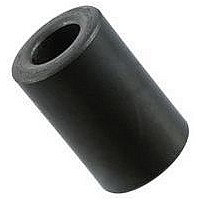0199000019 Fair-Rite, 0199000019 Datasheet - Page 149

0199000019
Manufacturer Part Number
0199000019
Description
BEAD KIT, EMI SUPPRESSION
Manufacturer
Fair-Rite
Datasheet
1.0199000019.pdf
(715 pages)
Specifications of 0199000019
Kit Contents
Contains 28 Different Beads In Three Suppression Materials, 73, 43 And 61.
Component Type
Shield Bead Kit
Lead Free Status / RoHS Status
Lead free / RoHS Compliant
Lead Free Status / RoHS Status
Lead free / RoHS Compliant
- Current page: 149 of 715
- Download datasheet (9Mb)
Phone: (888) FAIR RITE / (845) 895-2055 • FAX: (888) FERRITE / (845) 895-2629 • www.fair-rite.com
Fair-Rite Products Corp.
15th Edition
Introduction
Fair-Rite’s tile absorbers provide an attractive alternative to
traditional large, foam-type absorber materials for new anechoic
chambers or for upgrading older rooms for radiated emission
and immunity measurements. While ferrite tiles are a relatively
recent development, they have come into use wherever high
absorption (-15 to -25 dB at <100 MHz) and compact size (6mm
vs 2400mm for foam absorbers) are required. There are now
hundreds of installations worldwide in compact and 3/10 meter
FCC certified chambers. Ferrites themselves are inherently
immune to fire, humidity and chemicals providing a reliable
and compact solution for attenuating plane wave reflections in
shielded enclosures.
Theory of Operation
The basic physics of operation for any planar electromagnetic
absorber involves fundamental concepts as shown in Figure 1.
When an electromagnetic wave traveling through free-space
encounters a different medium (at Z=0), the wave will be re-
flected, transmitted, and/or absorbed. It is of course, the magni-
tude of the reflected signal which is usually of interest in this
application. For ferrite tiles, the thickness is tuned so that the
relative phases of the reflected and exiting wave cancel to form
a resonant condition. This resonant condition appears as a deep
“null” in the return loss response. This resonance is also a
function of the frequency dependent electrical properties of the
ferrite material such as relative permeability (m
(e
impedance (Z) and return loss (RL) according to the following
formulas:
Ferrite Tile Absorbers
for EMC Test Chamber Applications
Technical Information
G =
RL = 20 log
r
Z
) which interact to determine the reflection coefficient (G),
(888) 324-7748
f
=
Z
Z
f
f
+ Z
- Z
m
e
r
0
0
r
10
• tanh
(G)
[(
(dB)
j2 pd
l
)(
m
r
e
r
)]
r
) and permittivity
(888) 337 -7483
(ohm)
PO Box J, One Commercial Row, Wallkill, NY 12589-0288
Figure 1
Where :
Increasing Bandwidth
For some chamber applications increased absorber bandwidth
may be desired to comply with high frequency testing needs. One
technique shown in Figure 2 increases the bandwidth of ferrite
tile installations by mounting the tile over a dielectric spacer
(typically wood) of appropriate thickness. When both tile and
spacer thicknesses are optimized, the frequency response is
shifted upward to improve return loss performance from 600-
1500 MHz (see Figure 3). Of course, if increased bandwidth up
to 20 GHz is desired, several absorber vendors provide com-
pletely engineered hybrid absorbers using specially designed
pyramidal and wedge shaped dielectric absorbers matched to
ferrite tiles.
E
E
E
Reflected
i
r
t
Incident
,H
,H
,H
Z
m
m
Z
e
e
G = reflection coefficient of metal backed ferrite tile
d = thickness of medium 2 (ferrite)
wave
wave
1
2
o
1
2
f
i
r
t
= relative permeability of medium 1 (air)
= relative permittivity of medium 1 (air)
= relative permeability of medium 2 (ferrite)
= relative permittivity of medium 2 (ferrite)
= input impedance of metal backed ferrite tile
= impedance of free space (air)
= components of incident plane wave
= reflected components of incident plane wave
= transmitted components of incident plane wave
a nr
H r
Medium 1
H i
(e 1 , m 1 )
E r
E i
• E-Mail: ferrites@fair-rite.com
a ni
z – 0
x
y
Medium 2
(e 2 , m 2 )
H t a nt
z
E t
Transmitted
wave
Metallic
Surface
149
Related parts for 0199000019
Image
Part Number
Description
Manufacturer
Datasheet
Request
R

Part Number:
Description:
EMI/RFI Suppressors & Ferrites LF Z=95OHM @ 100MHz
Manufacturer:
Fair-Rite

Part Number:
Description:
EMI/RFI Suppressors & Ferrites Z=94ohms @ 10MHz
Manufacturer:
Fair-Rite
Datasheet:

Part Number:
Description:
EMI/RFI Suppressors & Ferrites LF Z=47OHM @ 100MHz
Manufacturer:
Fair-Rite
Datasheet:

Part Number:
Description:
EMI/RFI Suppressors & Ferrites Z=300 @ 100MHz
Manufacturer:
Fair-Rite
Datasheet:

Part Number:
Description:
EMI/RFI Suppressors & Ferrites Z=365 OHM @ 100 MHz
Manufacturer:
Fair-Rite
Datasheet:

Part Number:
Description:
EMI/RFI Suppressors & Ferrites LF Z=133OHM @ 100MHz T/R
Manufacturer:
Fair-Rite
Datasheet:

Part Number:
Description:
EMI/RFI Suppressors & Ferrites Z=132 OHM @ 100MHz
Manufacturer:
Fair-Rite
Datasheet:

Part Number:
Description:
EMI/RFI Suppressors & Ferrites Z=33 OHM @ 100MHz
Manufacturer:
Fair-Rite
Datasheet:

Part Number:
Description:
EMI/RFI Suppressors & Ferrites LF Z=78OHM @ 25MHz
Manufacturer:
Fair-Rite
Datasheet:

Part Number:
Description:
FERRITE CORE, CYLINDRICAL
Manufacturer:
Fair-Rite
Datasheet:

Part Number:
Description:
FERRITE BEAD, SMD, 350mOHM, 400mA
Manufacturer:
Fair-Rite
Datasheet:

Part Number:
Description:
FERRITE CORE, CYLINDRICAL
Manufacturer:
Fair-Rite
Datasheet:

Part Number:
Description:
FERRITE BEAD, SMD, 1.4mOHM, 5A
Manufacturer:
Fair-Rite
Datasheet:

Part Number:
Description:
CHIP BEAD,Ferrite
Manufacturer:
Fair-Rite
Datasheet:

Part Number:
Description:
SPLIT FERRITE CORE, 100MHZ, 290OHM
Manufacturer:
Fair-Rite
Datasheet:










